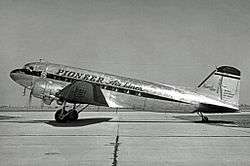Essair Airways
| Founded | 1939 |
|---|---|
| Ceased operations | 1955 |
| Fleet size |
Lockheed Model 10 Electras 23 Douglas DC-3s 9 Martin 2-0-2s |
| Destinations | See Pioneer Air Lines below |
| Headquarters | Houston, Texas, United States |

Essair Airlines, incorporated in 1939, was the first airline authorized by the federal Civil Aeronautics Board (CAB) to fly as a "local service" air carrier in the USA. It changed its name to Pioneer Air Lines in 1946 and served destinations in New Mexico and Texas. Pioneer and was acquired by and merged into Continental Airlines in 1955.
A commuter airline named "Pioneer Airlines" also operated in Colorado, Montana, New Mexico and Wyoming during the 1980s with Beechcraft 99 and Fairchild Swearingen Metroliner turboprop aircraft.[1]
Background
As airlines became more reliable, small communities demanded airline service. One of the first of this new type of airline was Essair, of Houston, Texas. Incorporated in 1939, Essair began a temporary service between Houston and Amarillo, via Abilene. On July 11, 1944 the Civil Aeronautics Board agreed that an experiment in subsidized short-haul and local scheduled air service should be conducted. The experiment involved the establishment of a new airline category, known as "feeder" or "local service" air carriers. On August 1, 1945, Essair became the first airline to fly under the new classification, with a temporary certificate.[2] and operated Lockheed Model 10 Electra twin prop aircraft on its routes within Texas and New Mexico.[3]
Pioneer Air Lines
The airline's name became Pioneer Air Lines in 1946. The Electras were replaced by Douglas DC-3s with 23 of the type being used between 1946 and 1953.[4] From June 1952, nine Martin 2-0-2 unpressurised airliners were operated by Pioneer after they were purchased from Northwest Airlines. Davies (and Killion) says the federal CAB forced Pioneer to revert to DC-3s in 1953; however, the February 1955 Official Airline Guide (OAG) was still listing several flights operated with the 36-seat Martin 2-0-2 "Pioneer Pacemaster" aircraft.
In April 1949 Pioneer scheduled flights to 24 airports in New Mexico and Texas from Albuquerque and El Paso in the west to Dallas and Houston in the east. In February 1955 it flew to 21 airports; later that year it was acquired by and merged into Continental Airlines.[5]
Destinations in 1953
The November 1, 1953 Pioneer Air Lines system timetable listed the following 22 destinations:[6]
- Abilene, TX
- Albuquerque, NM
- Amarillo, TX
- Austin, TX
- Big Spring, TX
- Breckenridge, TX
- Bryan/College Station, TX
- Clovis, NM
- Dallas, TX - Dallas Love Field
- Fort Worth, TX - Amon Carter Field - subsequently renamed Greater Southwest International Airport which was then shut down and no longer exists
- Houston, TX - Houston Hobby Airport - headquarters for the airline
- Lubbock, TX
- Midland/Odessa, TX
- Mineral Wells, TX
- Plainview, TX
- San Angelo, TX
- Santa Fe, NM
- Snyder, TX
- Sweetwater, TX
- Temple, TX
- Tucumcari, NM
- Waco, TX
Pioneer also previously served El Paso, TX, Las Cruces, NM and Roswell, NM in 1948 and Las Vegas, NM from 1948 to 1951.[7]
Following its acquisition of Pioneer, the April 1, 1955 Continental Airlines system timetable contained this message: "Now...ONE GREAT AIRLINE to serve you better! Pioneer Air Lines, serving 22 cities over 2000 route miles in Texas and New Mexico, officially becomes part of the greater Continental Air Lines system and opens a new era in air transportation for the Southwest!" [8] However, by 1964 Continental had ceased serving a number of the destinations previously served by Pioneer.[9]
Fleet
- Douglas DC-3
- Lockheed Model 10 Electra (initially operated by Essair)
- Martin 2-0-2
External links
- President Johnson Letter regarding ""Order Denying Petition for Rehearing, Reargument and Reconsideration"
- Ed Coates' Civil Aircraft Photograph Collection
Bibliography
- Gradidge, Jennifer (2006). DC-3 The First Seventy Years. Air-Britain (historians) Ltd. ISBN 0-85130-332-3.
- Marson, Peter J. (2001). The Lockheed Twins. Air-Britain (Historians. ISBN 0-85130-284-X.
References
- ↑ http://www.departedflights.com, April 1, 1981 Official Airline Guide (OAG), Denver flight schedules & July 1, 1983 Official Airline Guide (OAG), Albuquerque flight schedules
- ↑ FAA HISTORICAL CHRONOLOGY, 1926-1996
- ↑ Marson 2001, p.154
- ↑ Gradidge, 2006, p. 235
- ↑ Serling, Robert J., Maverick: The story of Robert Six and Continental Airlines (ISBN 0-385-04057-1), Doubleday & Company, 1974.
- ↑ http://www.timetableimages.com, Nov. 1, 1953 Pioneer Air Lines system timetable
- ↑ http://www.timetableimages.com, Oct. 12, 1948 & Feb. 1, 1951 Pioneer Air Lines system timetables
- ↑ http://www.timetableimages.com, April 1, 1955 Continental Air Lines system timetable
- ↑ http://www.timetableimages,July 29, 1964 Continental Airlines system timetable